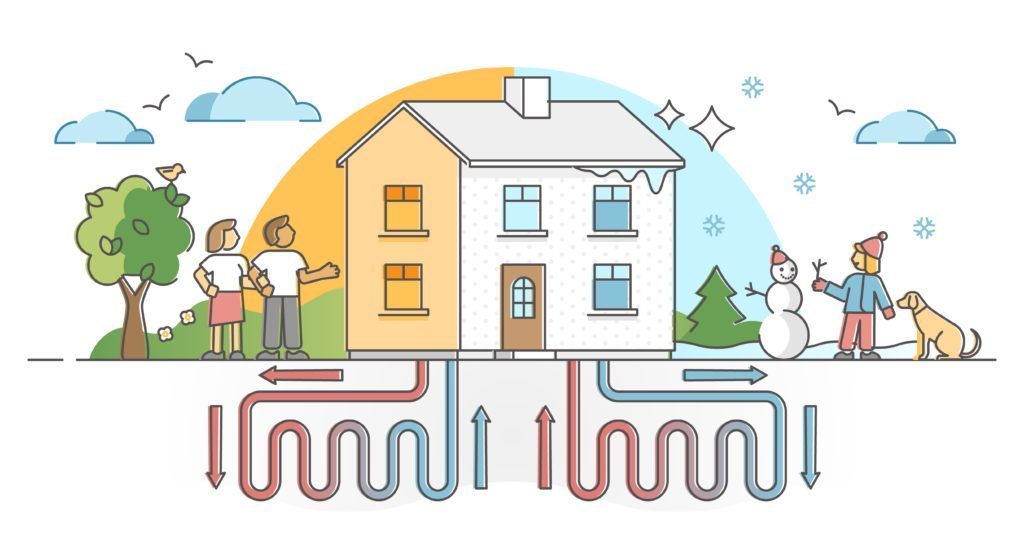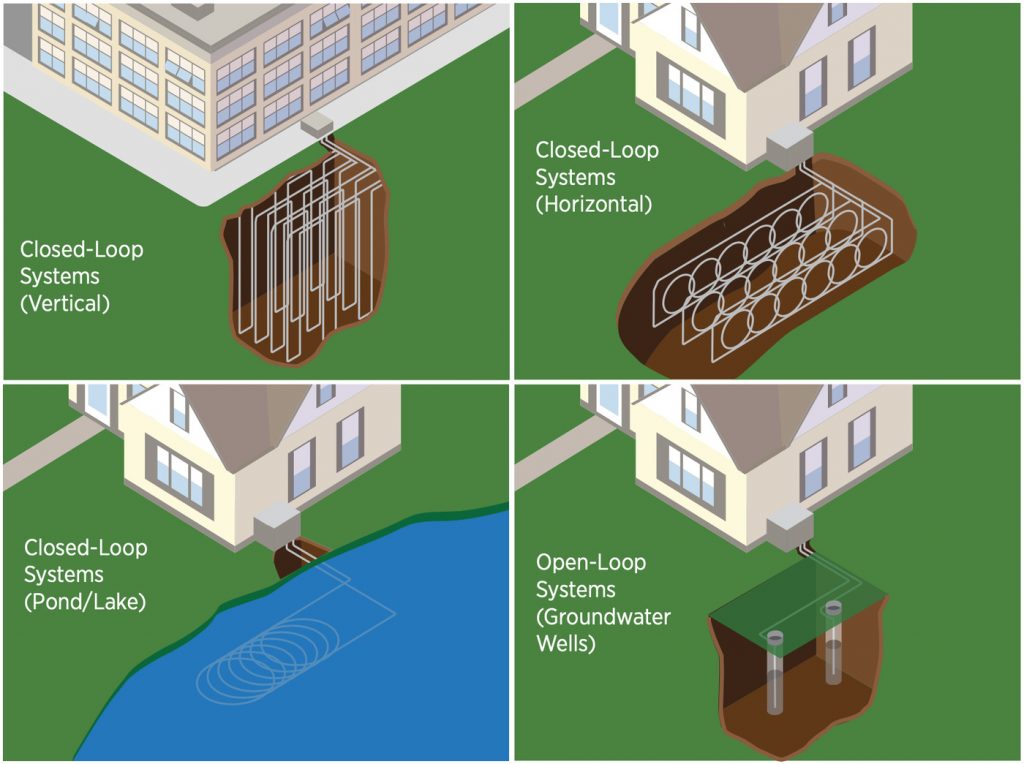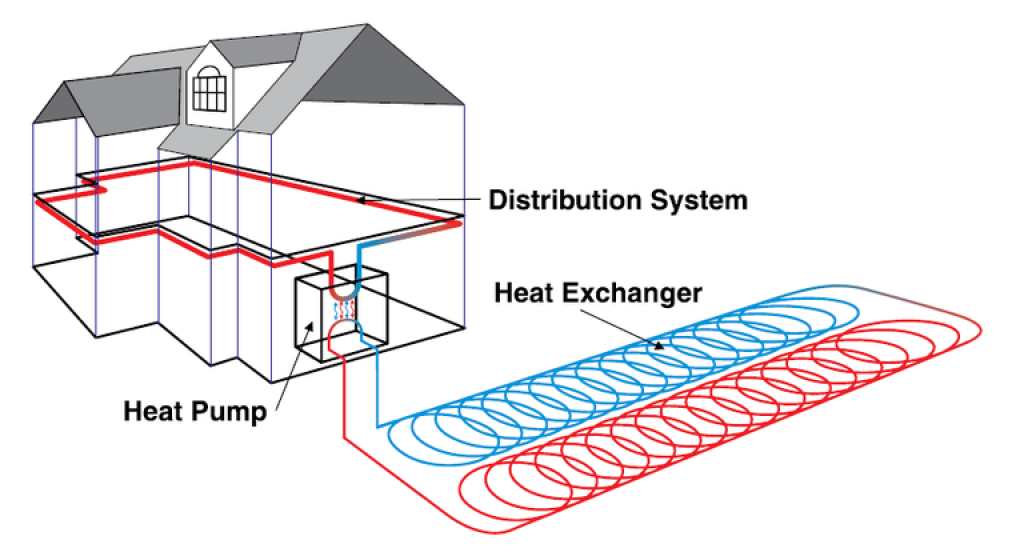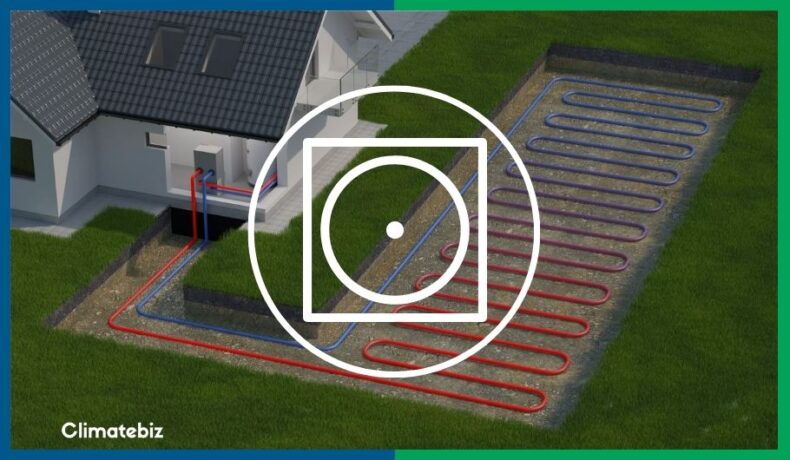Looking for energy-efficient, cost-saving methods to both warm-up and cool down your home? Then look no further than geothermal heating and cooling!
One of the fascinating aspects of geothermal energy is that it comes from within our Earth’s crust. As such, it’s more resilient, sustainable, and reliable. So, instead of using a conventional air-conditioner or older oil heating method, you can use a ground heat pump!
In recent years, geothermal heating and cooling have grown massively in popularity — people around the world are investing in these systems for their households and businesses. The results have been promising —many out there have had energy savings of over 50%
Needless to say, you can expect geothermal heating and cooling to continue growing for the foreseeable future.
So grab a cup of coffee and get comfy, you’re going to learn all there is to know about geothermal heating and cooling technology!
Table of Contents
What Is Geothermal Heating And Cooling?
Geothermal heating and cooling is the exchange of heat between the Earth or water, and ambient air temperatures. This renewable energy method usually takes place through circulating fluids and can be used for water temperatures, floor heating, and air cooling.
Essentially, geothermal heating and cooling systems produce area heating, area cooling, and water heating effects using the Earth’s natural temperature range.

Source: Neuhaus
How Does Geothermal Heating Work?
Many people use geothermal heating for floor heating, but it can also heat water in a house.
When the below-ground temperature is higher than the above-ground temperature, geothermal heat pumps circulate fluids to move heat upwards.
Think of it like this – heat pumps move heat from the ground into your household through heat exchange in the ground or water body.
How Does Geothermal Cooling Work?
When geothermal heat pumps work in reverse, they move heat from the household into the ground to cool fluids down. Once these fluids have circulated downwards, a cooling effect occurs through heat exchange.
Circulating fluids include anti-freeze chemicals. These fluids are designed to withstand even the coldest temperatures!
In short, geothermal cooling is a much greener alternative to the greenhouse gas emitting conventional air-conditioning systems.

Source: Symbiont Service
How Long Does Geothermal Heating And Cooling Last?
An advantage of ground source heating and cooling is the long-lasting technology.
Research shows that a ground source heat pump’s equipment can last up to half a century – the internal parts last for around 24 years.
The bottom line here is that these systems are long-lasting and reliable. This is a major bonus for those of you wanting to use earth’s energy!
Now that we understand how geothermal heating and cooling systems work let’s break down the costs of this technology.
Types Of Geothermal Heating And Cooling Systems

Source: D. Roberts
Each type of geothermal energy system comes with a different price tag. Before we give you the costs, let’s have a quick look at each of these systems.
Closed-Loop Control Systems
The following are examples of closed-loop control systems:
Horizontal Loop System
This system uses two pipes that are buried in a hole with a depth of around 5 ft and a width of 2 ft.
One of the hiccups many people encounter when installing this system is the large surface area it requires. However, there are new methods out there that help combat this issue.
The Slinky Method has become popular in recent years and involves laying shorter coiled pipes into the ground. The coiling reduces the large spaces required for installation.
Vertical System
Vertical systems are deeper but require less horizontal land.
These systems require the drilling of multiple holes around four inches wide and between 100-400 feet deep. Each hole is approximately 20 feet from another, where U-shaped pipes are connected to create a loop system.
The loops are later connected up to a heat pump in your household.
Pond/Lake System
If you have a pond or lake is in the vicinity of your household, you can use a pond/lake system.
In this system, a configuration of pipes runs underground into the water body where they coil at a certain depth.
This will be the most cost-effective option if the body of water meets all of your system’s depth and volume requirements.
Open Loop Systems
These systems are ideal when used with a borehole or water-well — this is even more true in vast areas across the U.S where soil conditions are less than perfect.
These systems circulate water and work through heat exchange directly with the ground.
How Much Does Geothermal Heating And Cooling Cost Per Month?
Geothermal heating and cooling systems are known to have a high upfront cost. This is because the installation process requires qualified professionals.
The good news — once you’ve installed your system, you’ll notice a reduction in your monthly energy bill.
Initial Installation
Let’s hit the ground running with the most expensive phase of a geothermal heating and cooling system — installation!
Important note: Before we begin, we have to impress upon you the importance of using a qualified professional for your system’s installation. You cannot overlook professional help because of the potential impacts on the environment associated with your system, as well as the long-term resilience thereof. What’s more, a qualified installer is vital if you’re considering applying for federal tax incentives relating to renewable energy.
Depending on the type of system you choose, your equipment can cost from $10 000 up to over $40 000.
The basic structure that will make up your system includes three main components:
- Heat exchanger (sometimes referred to as a loop which comprises circulating fluids)
- Heat pump with a condensing unit (the part that concentrates heat)
- Distribution system to spread the heat or cold

Source: North Dakota State University
The components will vary in price depending on the type of system you choose.
Cost Breakdown
| Geothermal Energy System Type | Estimated Cost Range |
| Horizontal System | $12 000- $35 000 |
| Vertical System | $20 000- $40 000 |
| Open Loop System | $10 000- $30 000 |
| Pond System | $10 000- $35 000 |
Installation services will bring with them additional costs, but it’s important to note that high-quality installation isn’t something you should slip up on!
These costs can be anything from double to three times the price of the basic equipment. However, the cost will depend on the amount of work necessary to install your system. For example, you’ll pay more if your system requires extensive excavation.
Related Reading: Pros & Cons Of A Geothermal Heat Pump
Operations And Maintenance
You can establish a monthly estimate during the operational phase.
Your ground source heating and cooling pump system will likely cost around $100- $200 in power fees per month. This amount will differ depending on your location and surrounding environment.
This excludes the running of extra pumps or backup heaters that you may need when the temperature drops to the point of it freezing system lines! In this case, the running costs may double.
Maintenance is a non-negotiable factor when it comes to the running of your geothermal heating and cooling system.
Cleaning your air ducts is an example of necessary maintenance. These services cost, on average, $500.
Additional Costs
Additional costs might pop up throughout the pre-installation, installation, or operating phase of your ground pump system.
These may include:
- Upgrading equipment for suitability: such as wiring in older homes before installation
- General upgrades: such as higher efficiency or better performing equipment
- Permits: installation permits can cost anything from $75 to more than $1000, depending on where you live
State Incentives And Credits
Did you know that green energy can come with reduced costs?
Depending on where you live, certain federal tax credits or rebates could greatly reduce your upfront expenditure.
If you live in the United States, you’ll be thrilled to know that governments may offer over 20% tax credit if you have a geothermal system installed when you use a certified system.
If you want to learn more, check out your local and regional state incentives to see what is applicable to your area.
Cost savings, here we come!
Final Thoughts
A great takeaway from this article is the choice of technology at your fingertips – geothermal heating and cooling systems come in all shapes and sizes suited to your requirements.
That being said, it’s important to keep in mind the costs involved from installation phase through to the operation of your system.
Whatever your situation, there is a ground source heat pump out there for you!

